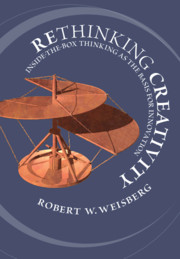Book contents
- Rethinking Creativity
- Rethinking Creativity
- Copyright page
- Dedication
- Contents
- Figures
- Tables
- Part I Introduction
- Part II Analytic Thinking in Creativity
- 3 Problem-Solving
- 4 Case Studies of Creativity
- 5 Analogical Thinking in Problem-Solving and Creativity
- Part III The Question of Extraordinary Thought Processes in Creativity
- Part IV The Psychometrics of Creativity
- Part V The Neuroscience of Creativity
- References
- Index
4 - Case Studies of Creativity
The Universality of Creativity
from Part II - Analytic Thinking in Creativity
Published online by Cambridge University Press: 01 October 2020
- Rethinking Creativity
- Rethinking Creativity
- Copyright page
- Dedication
- Contents
- Figures
- Tables
- Part I Introduction
- Part II Analytic Thinking in Creativity
- 3 Problem-Solving
- 4 Case Studies of Creativity
- 5 Analogical Thinking in Problem-Solving and Creativity
- Part III The Question of Extraordinary Thought Processes in Creativity
- Part IV The Psychometrics of Creativity
- Part V The Neuroscience of Creativity
- References
- Index
Summary
Rethinking Creativity proposes that all creative advances are based on analytic thinking – on ordinary thought processes, or inside-the-box thinking. Two predictions arise from that proposal. First, analytic thought processes should be found in all examples of creativity. Second, since analytic thinking is “ordinary thinking,” ordinary folks should be capable of creative thinking. Chapter 4 examines support for those predictions. The first section presents several case studies of genius-level creative advances, which demonstrate that seminal creative advances – creative achievements at the highest level – depend on analytic thinking, in particular analogical thinking. The next level of creative achievement is “professional creativity”, advances made by people in their professional activities. Several case studies show that the analytic processes are seen here as well. On a still-lower level we have day-to-day or under-the-radar creativity: those small-scale bursts of innovation that we all exhibit in our daily lives. Under-the-radar creativity closes the circle, showing that ordinary thinking underlies all creative advances and that creativity is universal among us.
Keywords
- Type
- Chapter
- Information
- Rethinking CreativityInside-the-Box Thinking as the Basis for Innovation, pp. 112 - 144Publisher: Cambridge University PressPrint publication year: 2020



